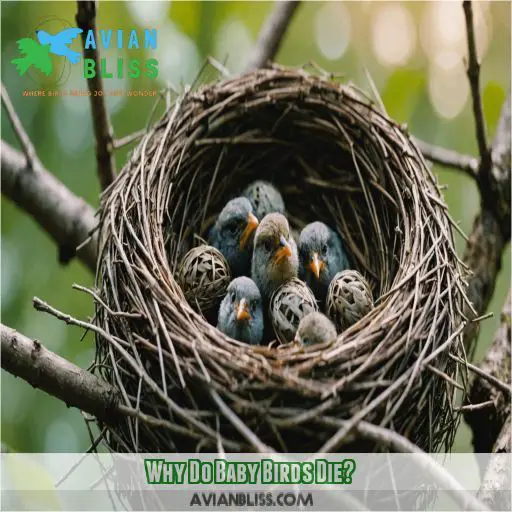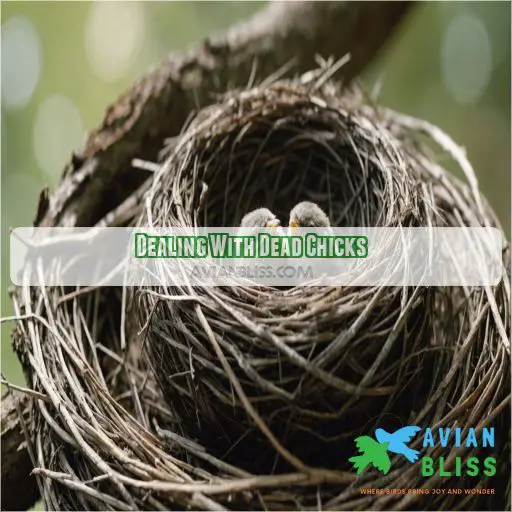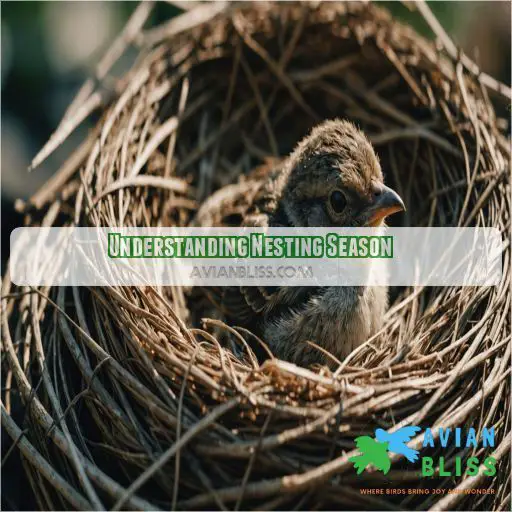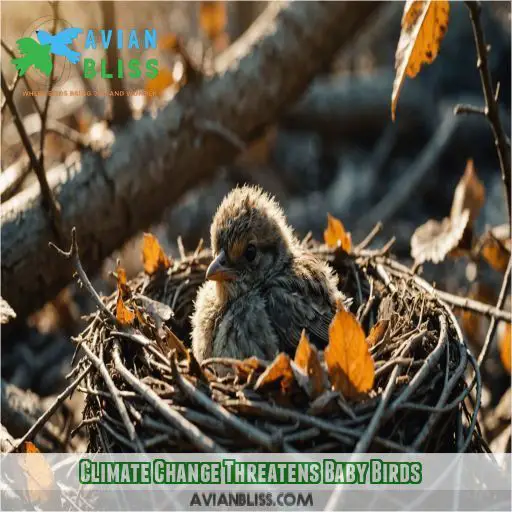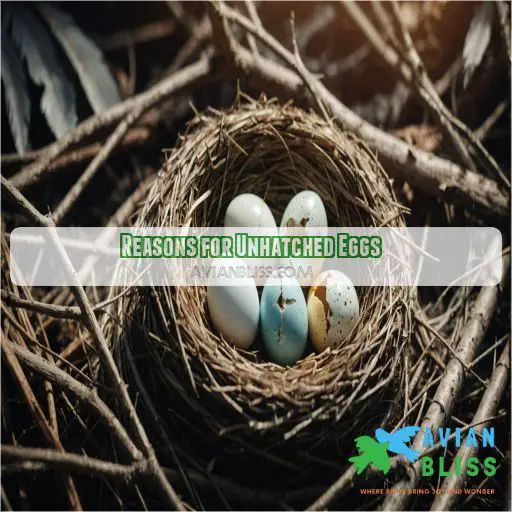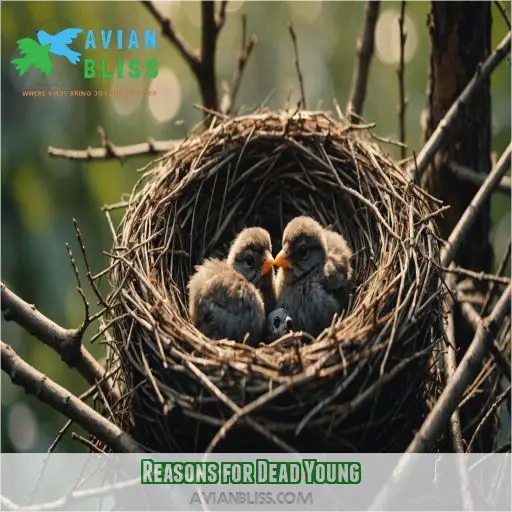This site is supported by our readers. We may earn a commission, at no cost to you, if you purchase through links.
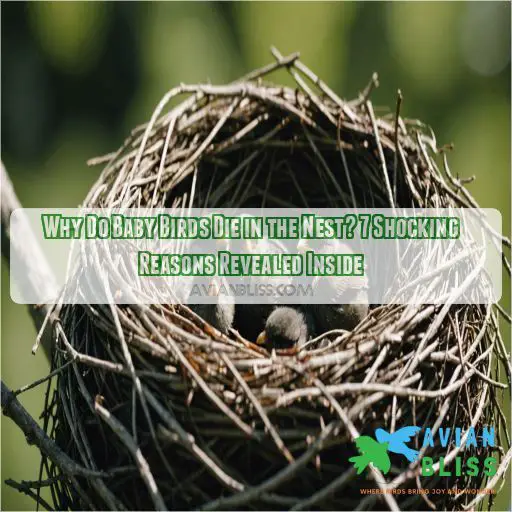
Baby birds die for various reasons, including nesting disturbance, parental abandonment, and environmental pressures.
You see, even with the best intentions, human activity can stress birds out, causing them to abandon their nests.
But don’t worry, by keeping a safe distance and minimizing intrusion, you can help reduce the risk.
Table Of Contents
- Key Takeaways
- Why Do Baby Birds Die?
- Dealing With Dead Chicks
- Understanding Nesting Season
- Tips for Birdwatching
- Climate Change Threatens Baby Birds
- Reasons for Unhatched Eggs
- Reasons for Dead Young
- Dealing With Inactive Nests
- Dealing With Active Nests
- Understanding Natural Nest Failure
- Frequently Asked Questions (FAQs)
- Why do baby birds suddenly die?
- Why would a bird die in a nest?
- Should you remove dead baby birds from a nest?
- Do birds know when their babies die?
- How do parent birds cope with the loss of chicks?
- Can baby birds survive outside the nest if abandoned?
- Do chicks in nests ever die from sibling aggression?
- How long does it take for chicks to decompose naturally?
- Can bird diseases be transmitted to other backyard wildlife?
- Conclusion
Key Takeaways
- Baby birds die in the nest more often than you’d think, and it’s not just because of predators or harsh weather – human activity, like disturbing the nest or using pesticides, can be a major culprit.
- Those cute little chicks are super vulnerable to disease, and if one of them dies, it’s essential to remove it ASAP to prevent the spread of disease and keep the rest of the brood safe.
- Parent birds are incredibly resilient and resourceful, and they’ve developed strategies to cope with the loss of chicks – they might even remove dead chicks themselves to keep the nest clean and free from disease.
- By understanding the reasons behind nest failure and taking simple steps like keeping a safe distance, minimizing disturbance, and providing food and shelter, you can make a real difference in helping baby birds thrive and grow into healthy, happy adults.
Why Do Baby Birds Die?
As you gaze out at the birds flitting about in your backyard, you may wonder why some baby birds don’t make it out of the nest. It’s a sad reality that many baby birds don’t survive to adulthood, but by understanding the reasons behind these losses, you can take steps to help these tiny creatures thrive.
Nesting Birds and Disturbance
You’re curious about nesting birds and disturbance. When you’re excited to check on those adorable baby birds, remember: a quick glance can cause parents to abandon their nest. Here are four things to keep in mind:
- Keep a safe distance: Avoid approaching the nest to prevent disturbance.
- Use binoculars: Get a closer look without startling the birds.
- Monitor from afar: Keep an eye on the nest without being too intrusive.
- Be patient: Allow the parents to care for their young without interruption.
Parental Instinct and Abandonment
When you’re trying to help baby birds, it’s important to remember that parental instinct plays a significant role in their survival. Unfortunately, this instinct can sometimes lead to abandonment. Stress factors, predator threats, and human impact can all contribute to nest abandonment. Here’s a breakdown of the stress factors that can lead to nest abandonment:
| Stress Factors | Description |
|---|---|
| Predator threats | Presence of predators near the nest |
| Human impact | Human activity, such as loud noises or approaching the nest |
| Nest relocation | Moving the nest to a new location |
| Lack of food | Insufficient food for the parents or chicks |
| Environmental factors | Extreme weather conditions or pollution |
Chickadees and House Wrens as Examples
You might be wondering why Chickadees and House Wrens are great examples to learn from. These birds are common backyard visitors, known for their adaptability and unique nesting habits. By studying their behavior, you’ll gain valuable insights into the importance of bird box design, nesting material, and food preferences, ultimately helping you create a safe haven for these amazing creatures.
Dealing With Dead Chicks
You’re probably here because you’ve stumbled upon a nest with a lifeless chick, and you’re wondering what to do next. When dealing with dead chicks, it’s really important to handle them properly to prevent the spread of disease and keep the nest safe for future inhabitants.
Removing Dead Chicks From the Nest
When you spot a dead chick in the nest, you really need to remove it to prevent disease spread and keep the nest clean. This might seem harsh, but it’s a super important step in caring for birds responsibly. Gently take out the deceased chick, and remember, this action helps protect the health and well-being of the other birds.
Disposing of Dead Chicks Properly
Now that you’ve carefully removed the dead chicks from the nest, it’s important to dispose of them properly to prevent the spread of disease. Place the chicks in a sealed bag and throw them away in the trash. This simple step helps maintain nest hygiene and is key for disease prevention, ensuring the health of future baby birds.
Cleaning the Nestbox Thoroughly
Time to scrub that nestbox! After disposing of the dead chick, mix 1 part white vinegar with 9 parts water, and use a soft brush to gently scrub away any debris or bacteria. Here are three things to keep in mind:
- Use mild disinfectants, like bleach or soap solution.
- Remove bird mites and parasites.
- Clean every 1-2 weeks to keep the nestbox safe for future use.
Replacing Nesting Material
When replacing nesting material, prioritize nestbox hygiene to make sure it’s a safe haven for future broods. Choose natural materials like twigs, leaves, or grasses, which birds often prefer. Avoid using materials that may retain moisture or attract pests. Consider the frequency of replacement, as some birds may reuse nesting material. Always prioritize bird preferences and safety considerations.
Understanding Nesting Season
You’re probably aware that baby birds can be quite delicate, and their survival depends on a multitude of factors, including the timing of their birth. Understanding the nesting season, which varies across different species, can help you make sense of why some baby birds mightn’t make it, despite their parents’ best efforts.
Varying Nesting Seasons for Different Species
You might wonder why some birds nest in tree nesting patterns tree nesting habits, while others wait until summer
. It’s because nesting seasons vary depending on the species! Each bird species has its unique schedule, influenced by factors like climate, food availability, and habitat suitability. Here are three examples:
- Robins typically nest in early spring, when earthworms are plentiful.
- Hummingbirds nest in late spring, when flowers bloom and nectar flows.
- American Goldfinches nest in mid-summer, when seeds are ripe and abundant.
Multiple Nesting Attempts in a Season
You might be surprised to know that many bird species make multiple nesting attempts in a single season! This depends on factors like food availability, nest site selection, and brood size. With favorable conditions, mating adults can achieve greater reproductive success. However, challenges like predator pressure, unshaded fields, and extreme temperatures can impact these attempts.
Late Nesting Season Challenges
You’re invested in the success of your backyard birds, but the late nesting season can be a challenging time for them. As the season progresses, food sources become scarce, and the risk of predation increases. Weather volatility can also make it difficult for hatchlings to survive. Let’s break it down:
- Food scarcity: Birds may struggle to find enough food to sustain their young.
- Predator risk: With more predators around, nests are more vulnerable to attacks.
- Weather volatility: Heat waves can dehydrate chicks, like little Albert, who rely on their parents’ fat reserves for survival – consider installing water stations to help them out!
Tips for Birdwatching
When you start birdwatching, you’ll want to make sure you’re doing it right – for both you and the birds.
By choosing a quiet spot, being patient and observant, and using a field guide, you’ll be well on your way to becoming an expert birdwatcher.
Joining a birdwatching club can also help you learn more about birds and connect with other enthusiasts.
These practices will also help reduce the likelihood of baby birds dying in the nest.
Choosing a Quiet Spot
When birdwatching, choosing a quiet spot is really important. Aim for areas with minimal human disturbance, like rural America‘s farming regions. Avoid setting up near bird feeding stations or food sources, as this can disrupt natural behavior. By minimizing noise pollution, you’ll increase the chances of observing birds in their natural habitat, undisturbed and stress-free.
Being Patient and Observant
Now that you’ve chosen a quiet spot, it’s time to be patient and observant. Grab your binoculars and get ready to learn from your feathered friends. Here are some tips to keep in mind:
- Take your time, as birds can be shy and may take a while to get used to your presence.
- Look for subtle clues, like changes in behavior or body language.
- Stay calm and quiet, as loud noises can scare birds away.
Using a Field Guide
You’re now a birdwatcher, armed with curiosity and a desire to learn. Using a field guide is key to identifying birds and understanding their behavior. Here’s a handy table to get you started:
| Field Guide Section | Description | Tips |
|---|---|---|
| Bird Identification | Photos and descriptions of species | Look for distinctive markings, beak shape |
| Species Behavior | Details on habits, habitat, and migration | Observe bird interactions, note habitat types |
| Habitat Types | Descriptions of environments, vegetation | Pay attention to nesting habits, food sources |
| Nesting Habits | Information on breeding, nesting, and young | Note nesting materials, locations, and timing |
| Conservation Tips | Advice on protecting bird populations | Support local conservation efforts, reduce carbon footprint |
With your field guide in hand, you’ll be well on your way to becoming a bird expert, and contributing to nationwide conservation efforts, like those led by the Cornell Laboratory of Ornithology.
Joining a Birdwatching Club
Now that you’re equipped with a field guide, it’s time to connect with fellow bird enthusiasts. Joining a birdwatching club is a great way to learn from experienced birders and gain new insights. Here are some benefits you can expect:
- Access to local clubs, field trips, and identification tips
- Opportunities to contribute to conservation efforts
- Connections with experts, like those from the Cornell Laboratory of Ornithology
Climate Change Threatens Baby Birds
As you explore the fascinating world of birds, you’ll discover that Climate Change poses a significant threat to baby birds, with rising temperatures and altered ecosystems affecting their survival rates. In this section, you’ll learn how heatwaves, habitat conversion, and bird decline are interconnected and what this means for the future of our feathered friends.
Heatwave Impact on Nestlings
As you enjoy birdwatching, you might wonder how climate change affects nestlings. Heatwaves have a devastating impact on baby birds, especially those in open nests or bird boxes without shade . A study by the Cornell Laboratory of Ornithology found that extreme heat really hurts reproductive success in birds, with temperatures in unshaded farm fields reaching 10°C higher than in nearby forests .
| Year | Nestling Survival Rate | Temperature Increase |
|---|---|---|
| 1998 | 60% | 0.5°C |
| 2005 | 55% | 1.2°C |
| 2010 | 50% | 2.1°C |
| 2015 | 45% | 3.5°C |
| 2020 | 40% | 4.8°C |
Habitat Conversion and Biodiversity
As you explore the great outdoors, you’re witnessing the devastating impact of habitat conversion on baby birds. Millions of young birds are dying due to extreme heat in farm fields across America. Agriculture conversion affects biodiversity, leading to species extinction, habitat loss, and fragmented habitats. It’s a harsh reality that highlights the urgent need for Conservation Efforts.
Bird Decline and Climate Change
You’re about to learn a shocking truth: climate change is a significant contributor to baby bird deaths. Here are four alarming facts about the impact of climate change on birds:
- Heatwave impact: Rising temperatures are causing heat stress in birds.
- Habitat loss: Changes in land use are reducing habitats for birds.
- Bird adaptation: Many birds can’t adapt quickly enough to climate change.
- Conservation strategies: We need new strategies to protect birds from climate change.
It’s time to take action and raise public awareness about this issue!
Reasons for Unhatched Eggs
You’re probably wondering why some baby birds don’t hatch, and it’s more common than you think. Several factors contribute to unhatched eggs, including infertility, environmental conditions, physical damage, late breeding season, and energy depletion – let’s explore these reasons together!
Infertility and Environmental Conditions
If you’re wondering why some eggs don’t hatch, consider that infertility and environmental conditions play a significant role. Factors like pesticide impact, climate change, and habitat loss can negatively affect egg quality, making them less viable (Source). As a bird enthusiast, you should understand how these issues can impact bird populations and their habitats, leading to food scarcity and decreased survival rates (Source).
Physical Damage and Late Breeding Season
You might be surprised to learn that physical damage to eggs can be a major reason for un hatched eggs. Late breeding season stress, food scarcity, and an increase in predators can all take a toll on eggs. With egg shell fragility, even the slightest bump can be fatal. It’s a vulnerable time for chicks, indeed!
Energy Depletion and Smaller Clutches
You’re wondering why some eggs don’t hatch? Energy depletion can be a major factor! When birds lay eggs, it’s an energy-intensive process. With food scarcity or other stressors, they may produce smaller clutches or not have enough energy to incubate eggs properly.
Here are 3 key things to keep in mind:
- Clutch size reduction: When food is scarce, birds may lay fewer eggs to make sure some chicks survive.
- Brood reduction: In times of stress, parents may focus energy on fewer, healthier chicks, sacrificing weaker ones.
- Parental stress impact: High stress levels can affect egg quality, making it harder for chicks to develop and hatch.
Reasons for Dead Young
You’re probably wondering why those adorable baby birds in your backyard nest didn’t make it, and it’s only natural to feel a little concerned. Well, it’s time to face the music: disease, predation, starvation, and even their own parents can be the culprits behind these tiny tragedies.
Disease and Predation
You’re not alone in wondering why baby birds die in the nest.
Disease and predation are two major culprits.
Bird diseases like avian pox and salmonella can spread quickly.
Nest parasites like mites and fleas can weaken young birds.
Predators like snakes, squirrels, and cats are also on the lookout for an easy meal.
Protect that nest and prevent disease!
Starvation and Incubation Issues
You might be wondering what other dangers baby birds face. Besides disease and predation, starvation and incubation issues are major concerns. When food is scarce, parents may struggle to keep their chicks fed, leading to malnutrition and weakened immunity. Here are some things to keep in mind:
- Food scarcity: Limited resources can lead to underfed chicks.
- Incubation time: Prolonged incubation can weaken eggs.
- Nestling health: Chicks need constant care to stay healthy.
- Parent stress: Overwhelmed parents might reduce feeding frequency.
Nest Abandonment and Disturbance
You’ve taken steps to prevent starvation and incubation issues, but another major threat looms: nest abandonment and disturbance. This can occur when parents feel threatened by human activity, predators, or loud noises. To minimize risks, keep a safe distance, avoid making sudden movements, and reduce noise pollution. By doing so, you’ll help keep baby birds safe and their parents stress-free.
Dealing With Inactive Nests
You’ve been patiently watching your backyard birds, and now that the nesting season is over, it’s time to think about cleaning out inactive nests. Before you start, make sure you’re doing it safely and legally – you don’t want to inadvertently harm any birds or attract unwanted critters to your yard.
Cleaning Out Inactive Nests
Alright, we talked about the tough stuff – finding a dead bird in a nest. Now, let’s deal with cleaning out a nest that’s been abandoned. It’s important to do this the right way, so here are some tips:
- Wait until the nest is inactive: Make sure there aren’t any eggs or baby birds still around before you start cleaning.
- Use the right nest cleaning tools: Grab some gloves, a soft brush, and a mild disinfectant.
- Follow legal guidelines: Check your local rules before you touch or take down a nest.
- Timing matters: Clean the nest when you’re sure it’s been abandoned so you don’t mess with the birds’ breeding season.
Disposing of Nest Materials
When disposing of nest materials, remember to do it responsibly.
Place the materials in a sealed bag and throw them away in the trash.
This prevents attracting pests and reduces the risk of disease transmission.
Follow local regulations and take necessary safety precautions to avoid any potential hazards.
Timing of Nest Cleaning
Now that you’ve disposed of the nest materials, it’s time to think about the timing of nest cleaning. Wait until you’re certain the nest is inactive – no viable eggs or live young. Check for signs of abandonment, like absent parents or debris. Follow local regulations and clean the nestbox when it’s safe and legal to do so.
Dealing With Active Nests
You’re probably wondering what to do when you stumble upon an active nest with eggs or young birds inside. It’s important to be careful and try not to disturb them too much, because even a quick glance can scare the parents away. If that happens, the babies are left alone and vulnerable to predators and bad weather.
Leaving Eggs and Young Alone
When dealing with active nests, you really need to leave eggs and young alone. Resist the urge to peek or touch them, as this can trigger parental instinct to abandon the nest. By giving them space, you’re supporting nesting success and contributing to conservation efforts. Remember, bird behavior is guided by instinct, and nest disturbance can be devastating.
Minimizing Disturbance
You’re doing great at leaving those eggs and young alone! Now, let’s minimize disturbance around the nest. Here are some tips:
- Keep your voice down, no yelling or loud noises, please
- Move slowly and calmly around the nest
- Avoid sudden movements or vibrations
- Keep pets and kids away from the nest
- Use binoculars to observe from a safe distance
Waiting Period and Incubation Variation
You’re waiting with bated breath for those eggs to hatch, but remember, incubation periods can vary. Don’t jump the gun and remove eggs too soon! Allow for possible delays and monitor the nest for signs of hatching. Keep an eye on parental behavior, too – they might be giving you clues about the nest’s success.
Understanding Natural Nest Failure
You might be surprised to learn that many bird nests are unsuccessful, even with human intervention – it’s just a natural part of the process. As you learn more about natural nest failure, you’ll discover that birds have adapted to compensate for these losses, and conservation efforts focus on reducing human-caused threats to bird populations.
High Nest Failure Rate
You might be shocked to learn that many bird nests are unsuccessful, even with human intervention. In fact, it’s estimated that up to 60% of nests fail due to natural causes like predation, harsh weather, and habitat loss. This high nest failure rate is a natural part of bird survival, where only the strongest and most adapted birds thrive.
Compensation for Losses and Natural Selection
Birds have clever survival strategies to compensate for losses.
They lay multiple eggs and have multiple broods to counterbalance natural mortality rates.
It’s like investing in a diversified portfolio – spreading risk to help them succeed.
This clutch size variation is an evolutionary adaptation that helps species thrive despite setbacks, all thanks to the refining fire of natural selection.
Conservation Efforts and Human Control
You’re not alone in wanting to protect these tiny creatures. While nest failure is a natural process, human actions can make a difference. Here are three ways to support bird conservation:
- Reduce habitat loss: Support sustainable farming and reforestation efforts.
- Provide food: Install bird feeders and keep them clean to prevent the spread of diseases.
- Responsible tourism: Respect birds’ habitats when traveling to reduce disturbance.
Frequently Asked Questions (FAQs)
Why do baby birds suddenly die?
You’re enjoying the wonder of baby birds growing in their nest, and then, suddenly, they’re gone. While it’s shocking, nest mortality is common, often due to harsh weather, disease, or even parents’ instinctual culling to help their young survive.
Why would a bird die in a nest?
You might wonder why a bird would die in its nest. Sadly, it can happen due to various reasons like disease, predation, starvation, incubation issues, or even environmental factors like extreme heat or cold.
Should you remove dead baby birds from a nest?
Your instinct might be to leave the nest undisturbed, but removing dead baby birds is really important to prevent disease and attract insects. Take out the deceased, clean the nest with a mild disinfectant, and let it air dry completely.
Do birds know when their babies die?
You might wonder if birds know when their babies die. Research suggests that birds can detect the viability of their eggs and may remove dead chicks to prevent disease and attract insects (Source).
How do parent birds cope with the loss of chicks?
You’re probably curious about how parent birds handle losing their chicks. Well, they often remove dead chicks to prevent disease and attract insects, and may even clean the nest to make way for new eggs .
Can baby birds survive outside the nest if abandoned?
If you’ve found an abandoned baby bird, don’t worry, it may still survive outside the nest. Observe from a distance to see if parents return; if not, you can intervene, but it’s really important to figure out the bird’s age and needs.
Do chicks in nests ever die from sibling aggression?
Life in the nest can be a ‘pecking order’ jungle! You might be surprised to learn that, yes, chicks in nests can die from sibling aggression, especially if food is scarce or parents are stressed.
How long does it take for chicks to decompose naturally?
When chicks die in the nest, you should remove them to prevent disease and attract insects. In a natural setting, a dead chick can decompose in just 2 or 3 days.
Can bird diseases be transmitted to other backyard wildlife?
When handling a nest with dead chicks, you risk transmitting diseases to other backyard wildlife. To minimize this risk, wear gloves, dispose of the chicks properly, and thoroughly clean the nestbox with a mild disinfectant.
Conclusion
You’ve just uncovered the shocking truth: baby birds die in the nest more often than you’d think – it’s a bird apocalypse out there!
But seriously, understanding why baby birds die in the nest is really important for bird enthusiasts and conservationists alike.
By recognizing the impact of human activity, environmental pressures, and natural factors, you can take steps to minimize nest disturbance and help these tiny creatures thrive.

